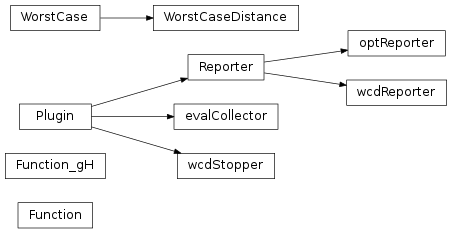6.3. pyopus.design.wcd — Worst case distance computation¶

Worst case distance analysis (PyOPUS subsystem name: WCD)
Computes the worst case distances of the circuit’s performances. Statistical parameters are assumed to be independent with zero mean and standard deviation equal to 1.
-
class
pyopus.design.wcd.WorstCaseDistance(heads, analyses, measures, statParamDesc, opParamDesc, fixedParams={}, variables={}, debug=0, linearWc=True, alternating=True, maxPass=20, wcStepTol=0.01, stepTol=0.01, constrTol=0.01, angleTol=15, stepScaling=4, perturbationScaling=64, screenThreshold=0.01, maximalStopperStep=0.5, evaluatorOptions={}, sensOptions={}, screenOptions={}, opOptimizerOptions={}, optimizerOptions={}, spawnerLevel=1)¶ See the
PerformanceEvaluatorclass for details on heads, analyses, measures, and variables.See the
WorstCaseclass for the explanation of statParamDesc, opParamDesc, fixedParams, maxPass, wcStepTol, stepTol, constrTol, angleTol, stepScaling, perturbationScaling, screenThreshold, maximalStopperStep, evaluatorOptions, sensOptions, screenOptions, opOptimizarOptions, optimizerOptions, and spawnerLevel options.Setting debug to a value greater than 0 turns on debug messages. The verbosity is proportional to the specified number.
If linearWc is set to
Truethe initial point in the space of the statistical parameters is computed using linear worst case distance analysis.This is a callable object with an optional argument specifying which worst case distances to compute. If given, the argument must be a list of entries. Every entry is
- a tuple of the form (name,type), where name is the measure name
and type is
lowerorupper - a string specifying the measure name. In this case the type
of comuted worst case distance is given by the presence of the
lowerand theupperentries in the measure’s description.
If no argument is specified, all worst case distances corresponding to lower/upper bounds of all measures are computed.
The results are stored in the
resultsmember. They are represented as a list of dictionaries with the following members:name- name of the performance measuretype-loweroruppernominal- nominal performancenominal_wcop- performance at nominal statistical parameters and initial worst case operating parameterslinwc- performance at the linearized worst case distance pointwc- performance at the worst case distance pointscr_stat- list of statistical parameters (screened)scr_op- list of op parameters (screened)lindist- linearized worst case distancedist- worst case distanceop- operating parameter values at the worst case distance pointstat- statistical parameter values at the worst case distance pointevals- number of evaluationsstatus-OK,FAILED,OUTSIDE+,OUTSIDE-,SENS+, orSENS-
Status FAILED means that the algorithm failed to converge in maxPass passes.
Status OUTSIDE+ means that the algorithm faield to find a point satisfying the WCD search constraint for positive WCD. This means that the WCD is a large positive value.
Status OUTSIDE- means that the algorithm faield to find a point satisfying the WCD search constraint for negative WCD. This means that the WCD is a large negative value.
SENS+ and SENS- are similar to OUTSIDE+ and OUTSIDE-, except that they occur when zero sensitivity to statistical parameters is detected.
Objects of this type store the number of analyses performed during the last call to the object in a dictionary stored in the
analysisCountmember.The return value of a call to an object of this class is a tuple holding the results structure and the analysis count dictionary.
-
formatResults(results=None, nMeasureName=10, nResult=14, nPrec=5, nEvalPrec=4, details=False)¶ Formats the results as a string.
nMeasureName specifies the formatting width for the performance measure name.
nResult and nPrec specify the formatting width and the number of significant digits for the performance measure values.
nEvalPrec is the number of spaces reserved for the evaluations count.
If details is
Truethe nominal performance, the performance the worst case operating parameters and the nominal statistical parameters, and the linear worst case distance are also formatted.
- a tuple of the form (name,type), where name is the measure name
and type is